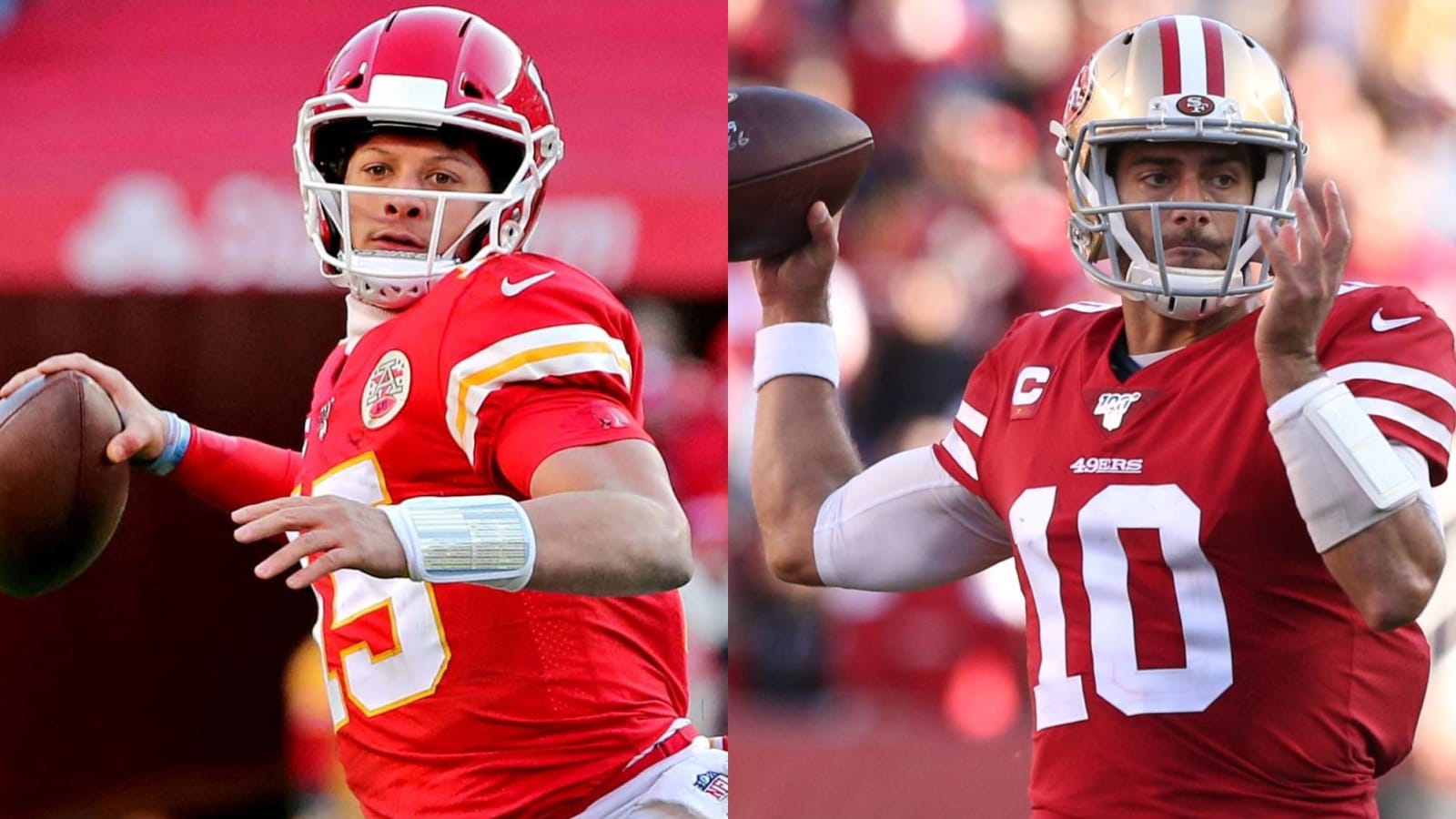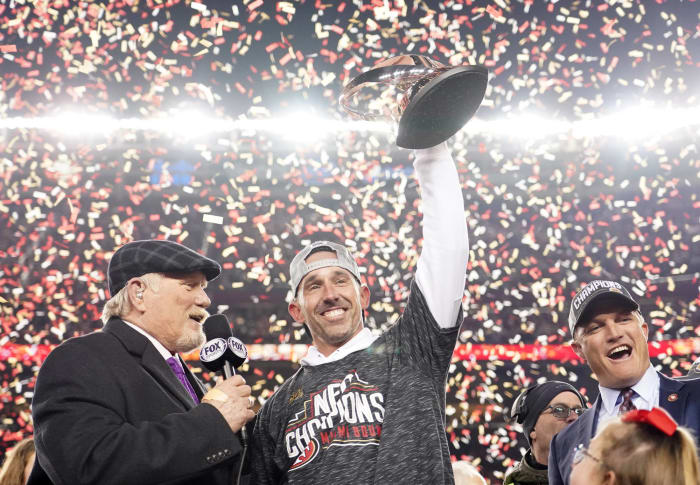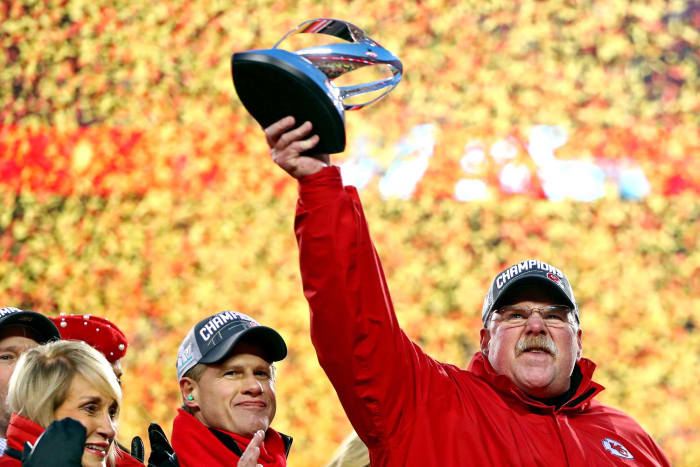
10 bold moves that put 49ers, Chiefs on road to Super Bowl
The Chiefs-49ers Super Bowl LIV matchup came to be because of several seminal decisions by each conference champion. Kansas City's ascension came after years on the precipice, and the 49ers completed one of the more remarkable rebuilds in NFL history.
Going into this era-defining matchup, here are five bold moves that shaped each franchise:

SAN FRANCISCO 49ERS (15-3)
1. Forming an unusual partnership
In 2017, San Francisco became the first team in nearly 40 years to have back-to-back one-and-done head coaches (Jim Tomsula and Chip Kelly). Then the team hired Kyle Shanahan as head coach and shocked the football world by pairing him with stealth GM candidate John Lynch, a Fox TV analyst without personnel experience. Each received a six-year contract. The 49ers went 10-22 from 2017-18 but only started QB Jimmy Garoppolo in eight of those games. (He missed 13 games last season because of a knee injury.) After the lengthy grace period, Shanahan and Lynch have the franchise in its seventh Super Bowl. The 49ers are the first team since the merger to follow four straight double-digit-loss seasons with a Super Bowl berth.
2. Adding foundational piece
The leadup to the 49ers’ Garoppolo acquisition remains a mystery. A trade candidate for much of 2017, the Patriots’ contract-year quarterback may or may not have been jettisoned against Bill Belichick’s will. Despite the Browns reportedly willing to offer an early-first-round pick for the passer, Belichick instead contacted Shanahan in October 2017 and agreed to take a second-rounder for Tom Brady’s seldom-seen backup. Shanahan was planning a 2018 Kirk Cousins pursuit, as the parties worked together in Washington. Garoppolo’s 5-0 record in 2017 as San Francisco’s starter convinced the 49ers to give him a then-NFL-high $27.5 million-per-year deal – albeit a front-loaded, team-friendly pact. Buoyed by a strong run game and resurgent defense, Garoppolo went 15-3 this season and posted a 102.0 passer rating, well above the league average.
3. A value bet on a Hall of Famer
The Legion of Boom’s top cornerback, Richard Sherman tore an Achilles’ tendon in November 2017. When the Seahawks released him in March 2018, the 49ers pounced. One of this era’s premier defenders, Sherman negotiated a three-year, $27.15M contract nearly devoid of guarantees. After a mediocre 2018 on a 4-12 49ers team, the 31-year-old boundary corner likely cemented his Canton credentials this season. Sherman bounced back and became a Pro Bowler and linchpin of a secondary that uses a similar scheme to Seattle’s. Entering the NFC Championship Game allowing a 35.2 passer rating over the past 13 contests, the three-time All-Pro proved skeptics wrong and helped coordinator Robert Saleh’s defense become a top-tier unit.
4. Vital overcommitment
Previous GM Trent Baalke used 2015 and ’16 first-round picks on defensive linemen Arik Armstead and DeForest Buckner. After collecting three draft picks from the Mitchell Trubisky-enamored Bears, Lynch made his first pick as GM defensive end Solomon Thomas. But neither Armstead nor Thomas moved the needle by 2018 as the 49ers ended a sixth straight season without a seven-sack edge rusher. They responded by trading a 2020 second-round pick to their Super Bowl LIV opponent for Dee Ford and using No. 2 overall pick in 2019 to select Nick Bosa, creating a five-first-rounder D-line. Bosa’s nine-sack, 25-QB hit season ignited the 49ers’ pass rush. Counting the playoffs, the Bosa-Armstead-Buckner-Ford foursome has 40 sacks. It terrorized quarterbacks all season, producing the team’s best pass-defense DVOA figure in 32 years.
5. A much-needed weapon
After a failed Pierre Garcon signing, Shanahan refused to wade deeply into the free-agency wideout waters in 2018 and ’19. But the 49ers’ George Kittle-dependent passing attack needed help, and shortly after the Patriots sent a second-rounder to the Falcons for Mohamed Sanu, Emmanuel Sanders was Bay Area-bound. The 49ers landed the 10th-year veteran from the Broncos for third- and fourth-round picks. This and the Dee Ford deal left the team without three of its top four 2020 selections, placing a bigger bet on this season. Headed for the Super Bowl with a third team, Sanders helped Garoppolo’s development while aiding rookie Deebo Samuel’s. The ex-Broncos Super Bowl 50 starter-turned-trade rental has 535 yards receiving as a 49er and proved a key upgrade.

KANSAS CITY CHIEFS (14-4)
1. Green-lighting a second chance
Andy Reid’s final two Eagles seasons featured the 2011 “Dream Team” finishing 8-8 and the ’12 squad going 4-12. A bad Chiefs era bottomed out in 2012, with their six-Pro Bowler team finishing 2-14. Hiring a 54-year-old coach known for January shortcomings was not viewed as a universal win for a franchise known for January agony, but Reid revitalized the Chiefs and moved to the Hall of Fame doorstep. Reid transformed Kansas City from 2-14 to 11-5 in his first year, took them to consecutive AFC championship games for the first time, and oversees the NFL’s premier offense. Reid helped turn raw QB prospect Patrick Mahomes into the league’s best player and has the Chiefs looking like the early favorite to be the team of the 2020s.
2. The Chiefs’ defining trade
Kansas City entered the 2017 draft without much upward mobility. The Chiefs’ Alex Smith-led team lost a playoff game in which its defense did not surrender a touchdown, but the 2016 squad’s 12-4 season had them picking at No. 27. Then-GM John Dorsey made one of this century’s most important moves, trading three draft picks – including the Chiefs’ 2017 and ’18 first-rounders – to move up to the Bills’ No. 10 spot and select Texas Tech's Mahomes. Once Mahomes received the keys following 2018’s Smith trade, the Chiefs ascended from an upper-middle-class team to true power. On a historic regular-season pace, Mahomes now has an 11-0 career playoff TD-INT ratio and has lifted the Chiefs to their post-merger apex.
3. Entrusting an embattled coordinator
The Patriots converting 13 of 19 third downs in last season's AFC Championship Game in Kansas City was the final straw for defensive coordinator Bob Sutton. While Reid probably held onto Sutton a year too long, replacing him with Steve Spagnuolo was risky. Although Spagnuolo ran the 2007 Giants’ championship defense, three of his previous four units coming into the 2019 season ranked either 31st or 32nd in yards allowed. After the Chiefs yielded 180-plus rushing yards in four straight games early this season, becoming only this century’s fourth team to do so, the hire looked even shakier. But in the final six games of the regular season and two playoff games -- all wins -- Kansas City has not allowed a team to surpass 125 rushing yards. The masterpiece came Sunday, when the Chiefs limited Titans running back Derrick Henry’s to 69 yards rushing.
4. Overhauling the edge
Dee Ford and Justin Houston combined for 22 sacks and 12 forced fumbles in 2018 but were ineffective in last year’s AFC Championship Game. In a three-day span in the off-season, the Chiefs released Houston and traded Ford. A team that had employed reliable edge rushers since the Jared Allen years had zero as free agency opened. The second-round picks acquired for Ford and CB Marcus Peters created the flexibility necessary to meet the Seahawks’ Frank Clark asking price in April. More reliable than Ford, Clark has 11 sacks in the Chiefs’ past 10 games and was vital to Kansas City’s pressure efforts against Houston and Tennessee in the playoffs. After injuries ended seasons for D-line newcomers Alex Okafor and Emmanuel Ogbah, Terrell Suggs fell into the Chiefs’ lap on waivers.
5. Swapping out safeties
The Cardinals’ then-safety-record contract for Tyrann Mathieu in 2016 did not work out, and it drove up Eric Berry’s price. Berry’s six-year, $78 million 2017 deal eclipsed Mathieu’s but burned the Chiefs when injuries soon ended Berry’s prime. Last year’s AFC title game illuminated the Chiefs’ secondary need. They attacked the problem by cutting Berry (and eating nearly $15M in dead money) and signing Mathieu. Released by the Cardinals in 2018 – leading to a one-year, $7M Texans deal – Mathieu landed another safety-record accord ($14M per year). The Honey Badger’s versatility has keyed the Chiefs’ defensive emergence. Kansas City’s No. 6 DVOA pass defense limited opposition following the team’s Week 12 bye and has complemented Mahomes’ machine-gun attack much better than last season’s unit.
More must-reads:
- Chiefs Super Bowl appearance leads to highest demand for tickets since 2012
- Reid can lock up Hall of Fame case with Super Bowl win
- The 'Second QB selected in the NFL Draft' quiz
Breaking News
Customize Your Newsletter
 +
+
Get the latest news and rumors, customized to your favorite sports and teams. Emailed daily. Always free!

